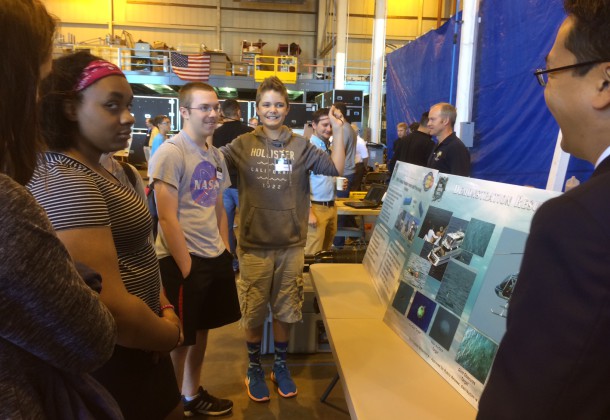STEM Success Requires Passion, Preparation

Some St. Mary’s County students recently shared a glimpse of some remarkable future options for themselves in science, technology, engineering, and math.
With concern growing in the US about the nation’s ability to produce a robust cohort of STEM graduates to drive technological innovation, Pax River took a proactive approach last month, hosting Pax River 2015, a major expo of unmanned underwater vehicle experimentation.
About 150 St. Mary’s County high school students in STEM programs attended the expo and got a challenging pep talk from someone who’s grabbed the brass ring of a STEM degree and wants to see others achieve similar success.
“The health of a nation’s STEM work force is highly correlated with a nation’s ability to sustain itself,” Dr. Jason Stack, Office of Naval Research program officer, told the students.
Productivity requires innovation, he said, and STEM professions drive the experimentation leading to innovation. Recruiting more students to STEM college programs is not only vital, it’s urgent.
With a Ph.D. from Georgia Tech and an MBA from MIT, Dr. Stack believes quality teaching makes the difference in the success or failure of STEM students. “The key factor here is good teachers, teachers that are passionate, creative, and truly inspire the students,” he told LexLeader. “Ask any professional in a STEM field and they can tell you about their Robin Williams/O-Captain-My-Captain type of teacher that inspired them.” However, the pay gap between a STEM teaching career and a STEM industry career may be keeping some talented teachers out of the classroom, he says.
Dr. Stack’s emphasis on quality teaching is key to understanding the way to raise STEM success because attracting students to STEM programs isn’t the problem, coaching them all the way to a degree is.
According to a 2013 report by the National Center for Health Statistics, about 28 percent of bachelor’s degree students and 20 percent of associate’s degree students chose a STEM major at some point within six years of entering post-secondary education in 2003−04. At the bachelor’s degree level, biological/life sciences was the most popular field, attracting 11 percent of students, and mathematics and physical sciences were the two least popular fields, attracting 2−3 percent of students. At the associate’s degree level, a higher percentage of students chose computer/information sciences (9 percent) than other STEM fields (1−6 percent).
The NCES analysis found that many of these STEM entrants left STEM several years later by either changing majors or leaving college without completing a degree or certificate. A total of 48 percent of bachelor’s degree students and 69 percent of associate’s degree students who entered STEM fields between 2003 and 2009 had left these fields by spring 2009. Roughly one-half of those who exited the field switched their major to a non-STEM field, and the rest left college without earning a degree or certificate.
Some might conclude that the difficulty of STEM coursework drives students away, but that isn’t the whole story: the study noted that attrition rates in non-STEM fields were as high as or higher than those in STEM fields.
STEM majors who were successful taking more demanding math courses their first year were more likely to stay the course in their STEM degree programs, the study found.
Another success indicator was the quality of their pre-college academic preparation.
St. Mary’s County Public Schools offers STEM programming to all students at three schools: Lexington Park Elementary School, Spring Ridge Middle School, and Great Mills High School. (Watch an overview of the STEM Academy program with student testimonials here.)
Dr. Stack also believes the personal passion of the college-bound student is central to academic success and establishing a path toward a satisfying professional future. “You have to go after what you love, but you have to think it through,” he told the students in the Pax River 2015 audience. “You have to be good at one thing before you can be good at everything.”
For example, “To be good at robotics you need to be good at electrical engineering, mechanical engineering, computer science, material science, etc.–it’s daunting,” he says. “Furthermore, students see that the good roboticists REALLY ARE good at all of these things–this can really make it overwhelming. However, the epiphany that we hope students have by the end of their bachelor’s degree is that all of these STEM fields are actually constituted by the same set of principles that simply manifest in different ways. For example, the mathematical equations for an electric circuit, a mechanical spring-mass-damper system, and a chemical mixing system are identical–absolutely the same. This is because it’s the same set of principles of physics that govern these seemingly different systems.
“Therefore, if you can find one area where you’re passionate and get a truly deep understanding of that area, then you can easily recognize those same principles that you already understand when they crop up in a different area–this allows you to quickly expand your expertise,” Dr. Stack says. “On the other hand, if you never truly understand any one area, then you’ll only see the world as unrelated fields of study and you’ll never be able to make the connections and pull it all together.”






















